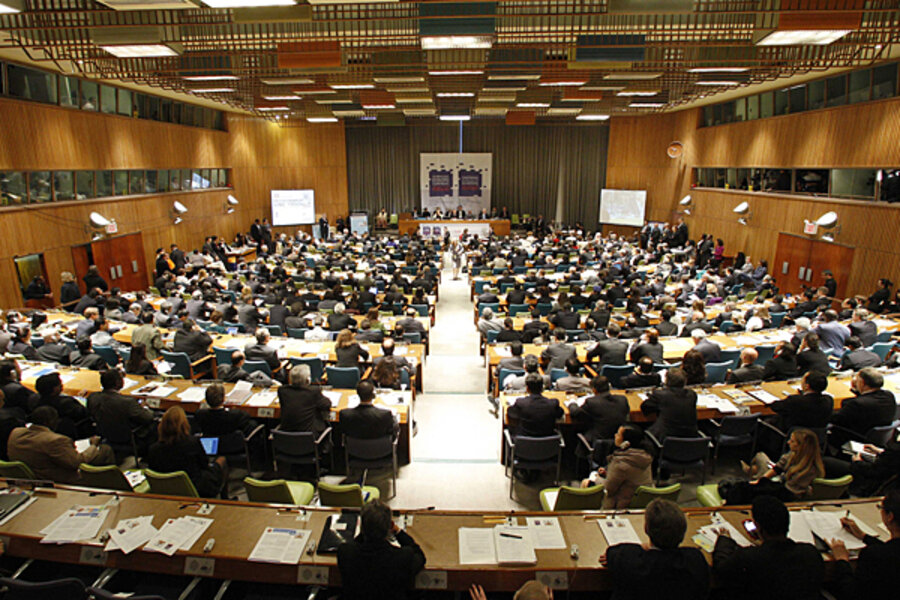UN Haiti conference: more than 100 countries pledge $15 billion
Loading...
| United Nations, N.Y.
The unprecedented international solidarity with Haiti following the Jan. 12 earthquake – from as far away as the republic of Georgia and as near as the neighboring Dominican Republic – proved to be unflagging Wednesday: Pledges of more than $5 billion in short-term assistance were made at a donors’ conference attended by more than 100 countries and international institutions.
Haitian authorities, who had asked for about $4 billion in aid for the next 18 months, described the outpouring as “testimony that Haiti is not alone.”
For their part, world leaders are hailing the generous support for the small Caribbean nation long dismissed as a basket case as a vote of confidence in the potential of collective international action. “This signals a new level off global cooperation and … commitment,” Secretary of State Hillary Rodham Clinton said at closing press conference.
In addition to the $5 billion in short-term aid, 48 countries and institutions pledged nearly $10 billion for Haiti’s long-term reconstruction needs over the next decade.
At the same time, leaders acknowledge that the effectiveness of the aid will be a test not just for Haiti but for the international community, as well. There is strong global skepticism about the effectiveness of the kind of massive rebuilding program that post-earthquake Haiti is undertaking.
“This is not only a conference about what we financially pledge to Haiti, we have to pledge to do better ourselves” at effective post-disaster rebuilding, Secretary Clinton said in opening the day-long conference.
'Build back better'
UN General Secretary Ban Ki-moon set the tone by telling the conference that the goal is “not just to rebuild, but to build back better.”
Among the long-term goals envisioned in an action plan unveiled by the government of Haitian President René Préval is a decentralized country based on smaller nodes of population in areas less prone to natural disaster than the capital of Port-au-Prince. The plan also targeted agricultural self-sufficiency and stricter building codes.
Most important, President Préval said, is development of an education system that does not leave more than one-quarter of Haitian children outside its doors, as the case even before the quake.
But many world leaders warned that the day-to-day living of millions of Haitians remains precarious. This is especially true for those living in unsanitary and unsafe conditions in makeshift camps, they say. A failure to address immediate needs could doom the long-term program.
Former US President Bill Clinton, who is Mr. Ban’s special envoy to Haiti, said that “until Haitians can live day-to-day and month-to-month” in healthy conditions and out of danger, it will be useless to expect the country to commit wholeheartedly to a long-term national reconstruction plan.
“We still have to move 20,000 to 40,000 people [from flood-prone camps] before the rains hit so they are not at risk of drowning,” Mr. Clinton said.
How the money will be handled
The billions of dollars in international aid is to be funneled through a new Interim Haiti Recovery Commission headed jointly by Mr. Clinton and Haitian Prime Minister Jean-Max Bellerive. That plan has met resistance from some countries and organizations that prefer to use their money as they see fit.
But international officials say past experience in similar cases has shown that one fund administered by the receiving country with international help is one key to success – especially in eventually transitioning to national “ownership” of the long-term plan.
The Haiti plan submitted by the Haitian government calls for substantial private-sector and NGO involvement, as well as regular consultation of the Haitian population through local discussion groups.
One example of private sector involvement: The Coca-Cola Company plans to team up with 25,000 Haitian mango farmers to improve their production and market accessibility – and to use their some of their produce for a new mango drink for Odwalla, which Coca-Cola owns.
Proceeds from every bottle of Haiti mango sold will go towards Haiti’s rebuilding effort.
Mr. Clinton told participants in the conference worried about the efficient spending of their donations that “transparency is a two-way street” – and he warned them with a smile that one of his priorities as co-chair of the Haiti interim commission will be to “show the commitments made and the money disbursed.”
The international community is notorious for making grand pledges but then failing to actually follow through with the money. Of the pledges committed to the UN’s flash appeal for emergency assistance to Haiti in the quake’s immediate aftermath, only 30 percent has been disbursed.





